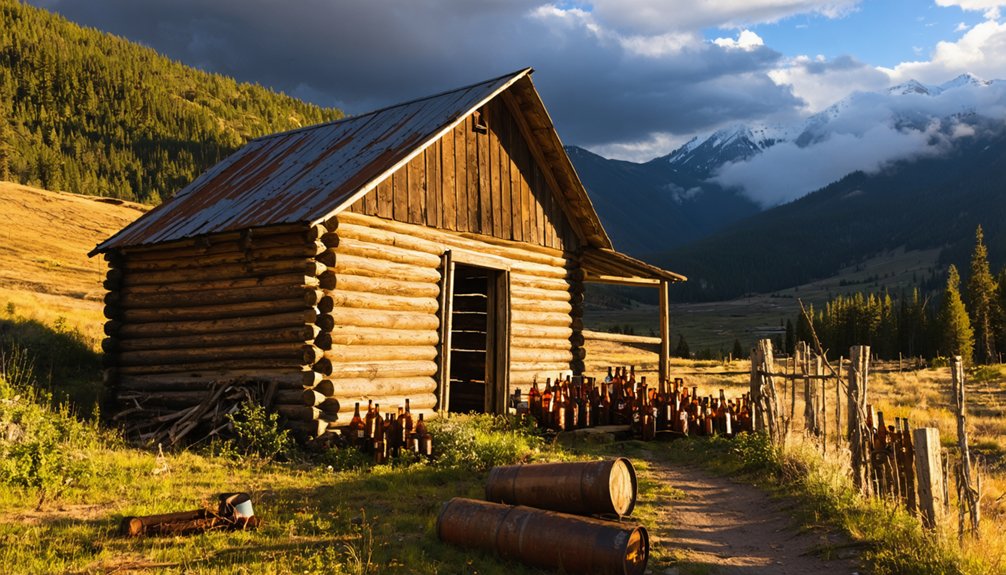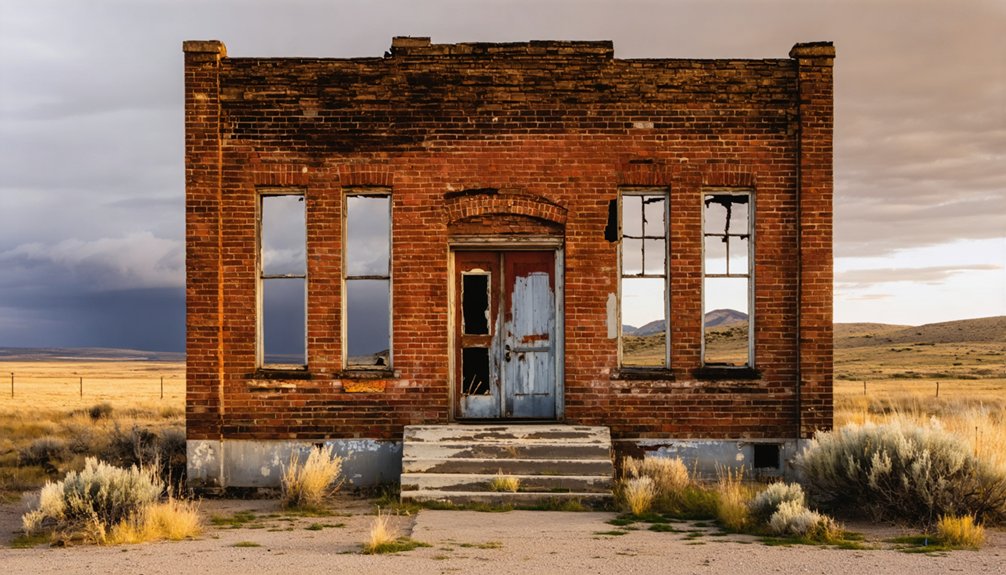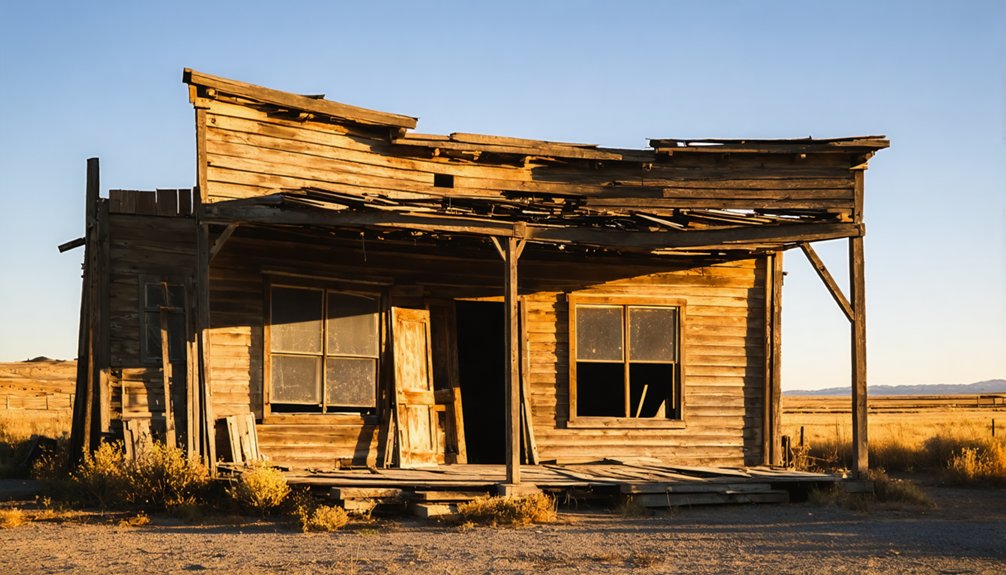You’ll discover Sawtooth City nestled at 7,342 feet in Idaho’s mountains, where Levi Smiley’s 1878 gold strike transformed wilderness into a bustling mining settlement. During its 1880-1886 heyday, this frontier town supported 600 residents with 25 substantial homes, saloons, and a robust commercial district anchored by the Columbia and Beaver Mining Company’s operations. Today, the National Register site’s foundations, lone cabin, and cemetery tell a compelling story of boom-and-bust in America’s mining West.
Key Takeaways
- Sawtooth City was established in 1878 after Levi Smiley discovered gold, growing into a thriving mining community at 7,342 feet elevation.
- During its peak from 1880-1886, the town supported 600 residents with 25 homes, businesses, saloons, and mining operations.
- The town declined in 1889 when local ore deposits were depleted, becoming a ghost town by the early 1900s.
- Archaeological remains include mill foundations, a log cabin, mining shafts, cemetery grounds, and scattered artifacts from frontier life.
- Listed on the National Register since 1975, Sawtooth City’s historic district preserves foundations and mining sites that produced silver.
The Birth of a Mining Town (1878-1879)
While the Northern Shoshone had long inhabited the Sawtooth Valley, the discovery of gold by Levi Smiley in 1878 transformed this remote Idaho wilderness into a bustling mining settlement.
You’ll find the town’s origins tied to the rich quartz outcroppings that drew prospectors to stake their claims in this rugged terrain.
The initial mining operations at an elevation of 7,342 feet required exceptional determination from the early settlers.
Peak Years and Prosperity (1880-1886)
During the peak years of 1880-1886, Sawtooth City transformed into a thriving frontier settlement of 600 residents, complete with 25 substantial homes and essential amenities.
You’d find restaurants, saloons, hotels, and important services like a post office, assay office, and general store supporting the economic boom.
The Columbia and Beaver Mining Company developed significant mining infrastructure, while the Galena Toll Road connected you to Ketchum.
Though major production didn’t begin until 1886, the town’s growth paralleled the success of nearby Vienna, which boasted over 200 buildings and its own newspaper.
Under W.S. Vernum’s supervision, a renovated mill operated successfully in 1886, while the Silver King mine thrived under Major William Hyndman’s leadership, marking Sawtooth City’s most prosperous period.
The discovery of gold on a creek bank in 1878 had initially drawn settlers to this promising location.
Three saloons and two restaurants became the social centers of the bustling mining community by 1885.
Life in a Thriving Mountain Community
If you’d visited Sawtooth City during its heyday, you’d have found a bustling mountain community where miners could spend their earnings at four saloons, three restaurants, and various merchants including a general store and meat market.
While the town lacked formal churches and schools, the saloons served as social hubs where residents gathered to swap stories, conduct business deals, and escape the rigors of mining life.
Your daily errands might’ve included a stop at the Chinese laundry, a visit to the assay office to evaluate ore samples, or picking up supplies delivered by wagon along Valley Road. Like many mining towns of the era, Sawtooth City was completely deserted by 1888, leaving only scattered remnants of its brief but vibrant existence.
Daily Commerce Activities
As Sawtooth City flourished in 1882, its bustling commercial district served a population supported by roughly 25 substantial homes.
You’d find daily trade centered around essential services like the meat market, assay office, and blacksmith shop, where miners could sharpen their tools and shoe their horses.
When you needed supplies, you’d head to the general store for mining equipment and household goods, while four saloons, three restaurants, and two hotels kept everyone fed and entertained.
The Columbia and Beaver Mining Company‘s investments made commerce possible, with their ten-stamp quartz mill processing precious metals and the Galena Toll Road connecting you to Ketchum.
The post office kept you connected to the outside world, while local merchants guaranteed crucial supplies reached this remote mountain community. Idaho’s arid mountain climate helped preserve many of these historic buildings, allowing visitors today to glimpse the town’s commercial past.
Social Life and Entertainment
While Sawtooth City’s population of 600 residents faced the challenges of mountain isolation, they created a vibrant social scene centered around the town’s three bustling saloons.
You’d find miners unwinding after long shifts, sharing stories over drinks and meals at the town’s two restaurants. Community gatherings often featured music and performances, though specific details haven’t survived in historical records.
The surrounding Sawtooth Mountains provided a natural playground for outdoor leisure activities, with residents heading into the wilderness for hunting expeditions and exploration.
The Chinese laundry added cultural diversity to the town’s social fabric. Despite technological limitations and the harsh mountain environment, you’d witness a tight-knit community where neighbors supported each other, gathering around campfires for storytelling and maintaining strong social bonds despite their remote location.
Mining Operations and Economic Impact
During the mining boom of the late 1870s, the Columbia and Beaver Mining Company launched ambitious operations in Sawtooth City by investing over $100,000 in infrastructure before extracting any ore. The mining investments included a $50,000 ten-stamp quartz mill and sawmill, though only $10,000 went directly to mine development.
Despite rich ore samples that initially attracted New York investors, operational challenges plagued the enterprise. The quartz mill, completed in 1882, didn’t run consistently until 1886.
While some veins yielded impressive grades – 30% lead, 5-6% zinc, and 150 ounces of silver per ton – expensive processing requirements limited profitability. The Silver King mine proved an exception, operating successfully until a devastating fire in 1892 ended large-scale mining.
The district’s total output reached approximately $250,000 before operations shifted toward ranching.
The Swift Decline and Abandonment

The combination of harsh environmental conditions and declining ore yields dealt a devastating blow to Sawtooth City’s future in the late 19th century.
You’ll find that the town’s fate was sealed by a perfect storm of environmental challenges and economic downturns. Mining claims became entangled in legal disputes, particularly those involving the Vienna Company, while dwindling mineral resources made operations increasingly unprofitable.
The town’s position near Galena Summit at 8,700 feet made winter survival particularly difficult for remaining residents. As services and opportunities disappeared, residents began their exodus, seeking better prospects elsewhere. The transformation was swift – by the early 1900s, the once-bustling mining town had become a ghost town.
The area’s subsequent shift to ranching and agriculture marked the end of its mining era, though you can still explore the remnants of this bygone community today.
What Remains Today: A Historical Treasure
If you visit Sawtooth City today, you’ll find the well-preserved foundations of an 1883 twenty-stamp quartz mill built by the Columbia and Beaver Company, alongside a surviving log cabin uniquely supported by pine trees.
The site’s archaeological significance is evident in its scattered artifacts, including twisted iron pieces and tin cans documented by Forest Service volunteers, while numerous building foundations reveal the town’s original layout near Beaver Creek and throughout the canyon. Most of the original structures have been reduced to difficult to find foundations.
The ghost town’s historical value extends to its cemetery with original gravestones, making it an important site for understanding late 19th-century mining settlements in Idaho’s Sawtooth Mountains. Once a bustling town that supported a population of six hundred people, Sawtooth City’s rapid decline came in 1889 when the local ore deposits were depleted.
Preserved Historical Structures
Standing as a lone sentinel amid the historic Sawtooth City site, a solitary log cabin represents the last intact structural remnant of what was once a bustling mining settlement.
While time and elements have claimed most of the historical architecture, you’ll still find tangible connections to the past through the preserved foundations and ruins scattered across the landscape.
- The sturdy stone foundations of the ten-stamp quartz mill, built in 1882, testify to the area’s mining ambitions.
- Carved bedrock features and mining shaft entrances reveal the determination of frontier prospectors.
- Mill building foundations stand as silent witnesses to the Columbia and Beaver Mining Company’s dreams.
- Cemetery grounds northeast of the site, with their weathered tombstones, tell personal stories of those who lived and died here.
Archaeological Evidence Today
Modern archaeological evidence at Sawtooth City reveals a complex tapestry of frontier life, with artifacts and structural remains painting a vivid picture of this once-thriving mining settlement.
You’ll find foundation remnants of the ten-stamp quartz mill, a solitary log cabin, and building bases scattered near Beaver Creek and the town center.
Archaeological digs have unearthed a wealth of artifacts documenting daily life – from twisted iron and rusted metal to blue glass shards and broken crockery.
The town’s cemetery, northeast of the camp, provides essential genealogical data through its weathered gravestones.
Despite bottle hunters’ disruptions, artifact preservation efforts continue, with ongoing Forest Service surveys uncovering new insights.
At 7,342 feet elevation, the site’s natural features and proximity to water sources help tell the story of this remarkable frontier settlement.
National Register Site Features
Listed on the National Register of Historic Places since 1975, Sawtooth City’s historic district preserves a remarkable collection of mining-era remnants at its 7,342-foot elevation setting.
The site’s historic preservation efforts protect essential features that tell the story of Idaho’s silver mining heritage, including architectural significance found in building foundations and industrial artifacts.
- You’ll discover foundations of 25+ substantial houses dating to the 1879-1886 boom period.
- You can explore the original Valley Road network, though now unpaved and overgrown.
- You’ll find evidence of mining operations that produced over 2.5 million ounces of silver.
- You can visit the community cemetery northeast of the townsite, an integral part of the historic district.
The rugged mountain terrain and proximity to Beaver Creek and Salmon River continue shaping the site’s preservation dynamics.
Legacy in the Sawtooth Valley
The rich legacy of Sawtooth City endures through its archaeological remnants and historical significance in Idaho’s mining heritage. Since 1975, the site’s cultural heritage has been protected under the National Register of Historic Places, where you’ll find foundation ruins, a solitary log cabin, and scattered artifacts that tell the story of this once-bustling mining town.
As part of the broader Sawtooth Valley mining district, the town helped shape the region’s development alongside Vienna, contributing to a thriving 19th-century economy based on silver, lead, and gold extraction.
Today, the ghost town serves as a reflection of the area’s mining culture, though bottle hunters have disturbed some areas. The Forest Service and volunteers work to preserve this important piece of Idaho’s past for future generations to explore and study.
Frequently Asked Questions
Can Visitors Legally Explore and Metal Detect at the Sawtooth City Site?
You can explore the site by walking established trails, but metal detecting regulations strictly prohibit any detecting or artifact collection. Following visitor guidelines guarantees you won’t face legal penalties.
What Happened to the Chinese Immigrants Who Operated the Laundry?
While thousands of Chinese immigrants left Idaho after 1880s mining declined, you’ll find the laundry operators likely moved to larger cities like Boise or returned to China, leaving their immigrant contributions largely undocumented.
Were There Any Famous Outlaws or Notable Crimes in Sawtooth City?
You won’t find any documented outlaw legends or notable crime history here – despite the Wild West setting, historical records don’t show any famous bandits or significant criminal activity in this mining town.
How Harsh Were Winters, and How Did Residents Cope With Isolation?
You’d face brutal winters with -50°F temperatures and 75-inch snowfalls. Your winter survival depended on stockpiling supplies, maintaining strong community bonds, and mastering isolation strategies like hunting and trapping.
Did Any Original Sawtooth City Families Continue Living in Idaho Afterward?
You won’t find documented family legacies of original miners continuing in Idaho afterward. While some ranchers moved into the valley, there’s no evidence of Idaho descendants from Sawtooth City’s first residents.
References
- https://idahorocky.com/history/sawtooth-valley-bragging-rights-random-facts/
- https://en.wikipedia.org/wiki/Sawtooth_City
- https://www.sawtoothcityidaho.com/history
- https://idaho-forged.com/idahos-ghost-towns-eerie-yet-approachable/
- https://www.samanthastclaire.com/post/traveling-the-road-to-sawtooth-city
- https://history.idaho.gov/wp-content/uploads/2018/09/Sawtooth_City_75000625.pdf
- https://history.idaho.gov/wp-content/uploads/0207.pdf
- https://www.hmdb.org/m.asp?m=110045
- https://visitidaho.org/things-to-do/ghost-towns-mining-history/
- https://www.wildernessneed.org/wp-content/uploads/Sawtooth-Smiley-Creek-Historic-Page.pdf



